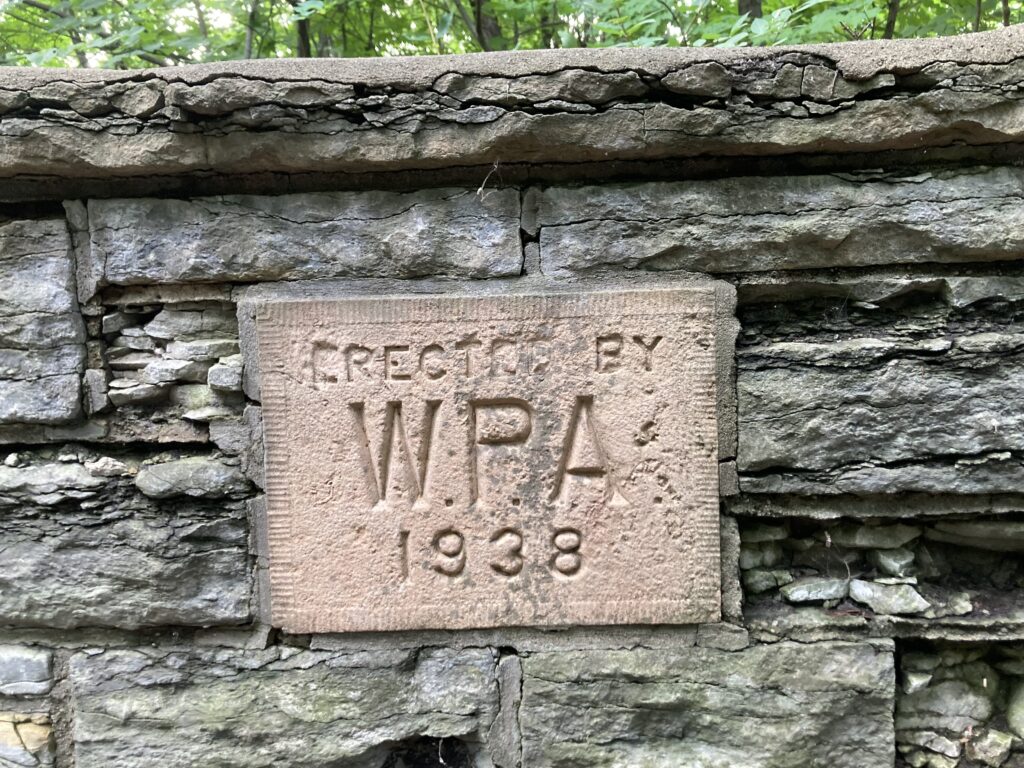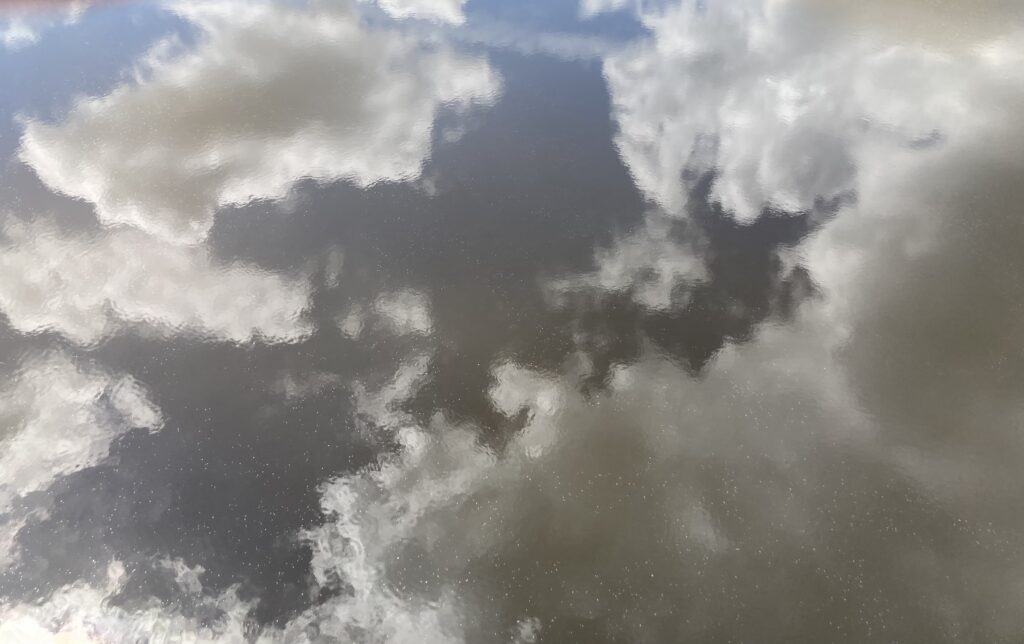swim: 4 loops
lake nokomis open swim
89 degrees
choppy
A great swim, but choppy! Lots of breathing on one side to avoid waves. Sighting buoys (and other swimmers) was harder, everything lost in the waves. The first loop was the toughest. Got into a groove after it and managed to do 2 more loops before pausing to tread water at a white buoy and then beginning the final loop. It was crowded in the water — kids wading at the beach, adults taking advantage of the free night at open swim. Because of the crowds and the choppy water, it was difficult to give attention to the water or the bubbles or anything else. Did I manage to notice 10 things?
10 Things
- sparkle friends — particles floating, churning in the water
- so many vines reaching up from the bottom, wrapping around my wrist or ankles — it didn’t bother me, but I could imagine that freaking out some other swimmer
- a plane flying low, parallel to the water
- hot pink safety buoys tethered to torsos
- the pale foot of a breaststroker under the water
- the silhouette of an upright lifeguard on a kayak, marking the edge of the course
- someone swimming at the edge of my vision — far off to the left
- 3 swimmers with yellow safety buoys clustered together, treading water and talking
- mostly blue sky, a few clouds
- paused at the buoy, witnessing a strange sight: the way a swimmer was breathing and sighting in the choppy water, jerking their head high up and out of the water — at first I thought they were doing a double-take when they noticed me, but nope, that’s just the way they swim
before the swim
Each summer of swimming builds on the last. I get stronger, able to swim for longer without stopping. It’s not a deliberate choice or part of a training plan — I have no training plan for swimming; I just swim until I am too tired or I have to go to the bathroom or I’ve run out of time. I have loose goals: 100 miles for the summer or a 5k or 6 loops or the full 2 hours in one session. This year: swimming cumulatively for a day, or 24 hours, in August. It’s a goal inspired by the title of a Mary Oliver poem: Swimming, One Day in August. It’s possible, but it will take some planning and pushing myself to achieve.
In July, I’m finding myself thinking about how much time I’m spending above the surface versus below it. This year, I’m below much more than above. In past summers, I’ve done less loops and more stops at shore in-between. This year, I might occasionally pause mid-lake for 5-10 seconds, or take a 30 second break at the beach between the 3rd and 4th loop, but mostly I’m swimming freestyle without stopping. 60-90 minutes of 1 2 3 4 5 breathe right 1 2 3 4 5 breathe left. That’s a lot of time submerged and becoming acquainted with the underwater world!
Below, my thoughts are the bubbles that surround me. Above, they become words that hover above the water or travel across the lake — maybe they get lost beyond the horizon, or maybe they linger, later taking the form of words on a page. Last night, swimming the stretch from hidden beach back to point beach, I imagined each breath as one word bursting into the air: 1 2 3 4 5 BLUE 1 2 3 4 5 GRAY. I didn’t get very far with my words before I was distracted by something — another person? a scratchy vine? trying to sight an invisible buoy? I’d like to play around with this some more while I’m swimming tonight. Does each breath have to be only one word?
My ideas about thoughts below and above the water are partly inspired by the lines from Alice Oswald that I’ve memorized and have been reciting in my head:
dived again and surfaced
and smelt all the longings of grass-flower smells
and bird-flower sounds and vaporous poems
that hang in the chills above rivers
(Nobody/ Alice Oswald)
the vaporous poems as my thoughts bursting into the air and hanging above the surface?
and thoughts escaping to the surface to move beyond the self
I wish I was there or there he thinks and his mind
immediately
as if passing its beam through cables
flashes through all that water and lands
less than a second later on the horizon
and someone with a telescope can see his tiny thought-forms
floating on the sea surface wondering what next
*
like spirits of sight whose work is on the water
where the massless mind undulates the intervening air
shading it blue and thinking
I wish I was there
or there
All the time in the water, the front half of me submerged except for my quick breathe every 5 strokes, has me wondering about which world is real, which a dream. On 3 July, I posted a quotation from Anne Carson that ended with, Could we be exactly wrong about such things as—he rotates again—which way is up? High above him he can feel the clouds watching his back, waiting for him to fall toward them. Which way is up, which down?
I’m thinking of May Swenson’s “Water Picture” and her vivid description of a water world as the world above water in reverse:
Treetops deploy a haze of cherry bloom for roots, where birds coast belly-up in the glass bowl of a hill
The first line of her poem — In the pond in the park
all things are doubled — reminds me of something Alice Oswald said in her “Interview with Water” lecture: when you look at water, it allows you to exist twice but more darkly (see full quote from 20 june 2024)
And that line reminds me of part of Oswald’s Nobody:
I lost track of
the underneath of things everything became my mirror
once I stood up to look over the side
I sat down again terrified it was myself I saw
thronged and pitch-green
spilling over the top of the earth
the same soft dust-sheets over my hands as the clouds
the same thick curtain across the horizon
Above and below the surface is not just reversal, the same backwards, symmetry, but something else. In her lecture, the lines before the bit about twice darkly, Oswald says:
but the surface of water is complicated by transparency, and its transparency is complicated by refraction. Water is never the same as itself. Rivers can only exist as similarities, lakes reflect more than their own volume
The surface offers the illusion of reversal, one way up, the other down. Below the surface, beyond its mirror, another world waits to be witnessed. And not with eyes — the visibility in lake nokomis is currently 6.6 feet. In the middle of the lake, all I see below me are particles, stray vines, an occasional flash, and murky green-blue-yellow. Not so much dark, as Nothing.
I’m fascinated by surfaces, or what Oswald calls the waterlid. What does the surface look like from below looking up? I should make note of it today. Also, from above, looking down?
Looked up some notes, and found this great quotation from Darby Nelson in his book, For the Love of Lakes:
Human understandings rely heavily on the endless flood of messages from our eyes. But with a lake, the laws of optics work against us. Its reflective surface and the water’s rapid absorption of light with increasing depth conspire to keep much of a lake hidden from view. At a lake, open your eyes and you don’t see half of it. Nearly all the visual input from a lake comes as surface reflections, mere superficialities. Thoreau reveled in reflections. He felt because they were constantly changing they could present previously known truths from new points of view. But those truths don’t penetrate into the world of the lake below, a truth with which he seems unconcerned. What kind of landscape even exists in the absence of vision? How can we fully perceive what we cannot see?
For the Love of Lakes/ Darby Nelson
during the swim
I wanted to think about these things and recite some lines as I swam, but I was distracted by the effort of choppy, crowded water, always looking out for waves crashing over me and making it hard to breathe, or random slow or stopped swimmers. Near the end of the swim, I decided to dip lower in the water so that I could see the surface from below — a wavy, slightly distorted version of the sky and clouds. Cool!


